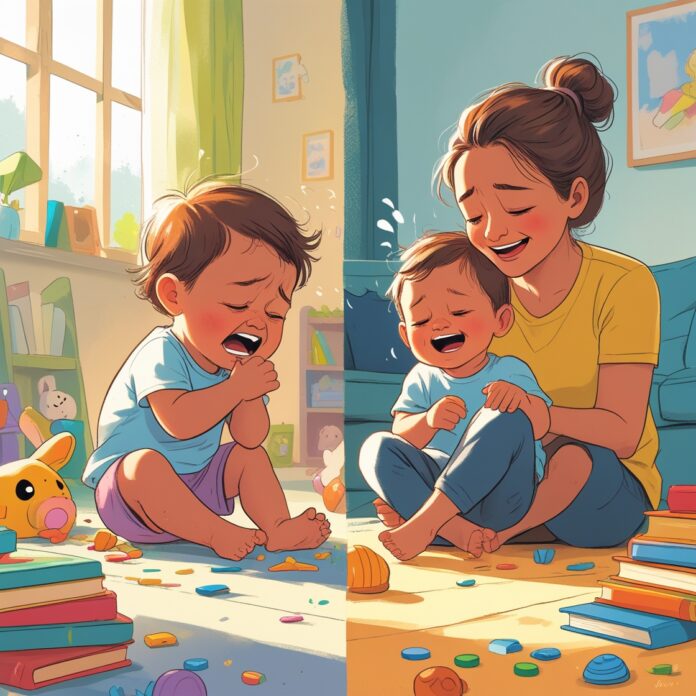It’s an up-and-down ride with a toddler: from laughing to crying in a blink of an eye. Often a child doesn’t even need a major event to throw a tantrum. An episode like a toy not working right can set it off. The most frequently asked question is, “Is this normal?” and to your relief, yes. Toddler tantrum is a natural part of development in early childhood. However, nothing really changes that makes them easier to handle.
This blog provides solutions to toddler tantrums based on psychology and real-life parenting that gets to the core of the problem. Whether you’re a first-time parent or a seasoned caregiver, this guide offers practical, compassionate ways to transform chaos into connection.
Written by Feng Shui and Healthy Living, the blog gives us important insights to the problem, along with the most effective and practical suggestions for parents.

Why Toddlers Have Tantrums
The first step is to know what causes tantrums in toddlers.
Toddlers at the ages of 1 to 3 years are in the middle of the phase of very rapid cognitive and emotional development. This is the period when they are catching on to how to name and communicate things but can’t keep up. Major triggers of the tantrum stage are:
- Being hungry or tired
- Having too much stimuli
- Wanting to do everything themselves (“I do it!”)
- Not having the opportunity of getting what they want
- Being unable to express their emotions
Understanding the “why” would drive us towards sympathetic rather than angry reactions. It is always good to know that the children are not intentionally doing it ; they just get dysregulated.
Strategy 1: Stay Calm (Even When They’re Not)
Have you heard that the great rule of the problem is not to lose your cool? Take care of you first. Remember that kids learn to regulate their emotions through the adults. Yelling or reacting with anger can definitely only make things worse.
Pro Tip: Before answering, take a deep breath. Your language and body should remain calm and open. Remind yourself: it is not that they do not want to obey you—this is a case of emotional breakdown.
Strategy 2: Do not downplay their Emotions, and Give them a Familiarity
Surely, saying “You’re okay” to a toddler who is feeling overwhelmed is not really a huge help. On the other hand, saying “You’re feeling really mad because we had to leave the park” is not only validating for the child, but also helps to locate the exact emotion:
“It’s hard when you can’t have the toy you want.”

Being able to name their emotions is a way for your child to learn the language of feelings and be understood, which is really crucial in emotional development.
Strategy 4: Use Distraction and Redirection
Redirection can be forceful for toddlers. They are text span and thus, prone to curiosity.
If your child is screaming for candy in the checkout line, point out something fun nearby: “Look at the balloons by the door!”
Give a toy or a job to help them refocus from the triggering issue.
Doing this is not ignoring, but an artful way of dealing with the situation, in order to prevent things from getting worse.
Strategy 5: Set Clear and Consistent Limits
Gentle parents are not the same as lenient parents. Children at this developmental stage need and are most at ease with precise expectations and clearly set rules. Saying “no” is okay, and also, healthy, it is a must-do, only when done peacefully and with care.
In place of:
“Stop crying — you’re being bad.”
Try:
“I see you’re upset, but we don’t hit. Let’s take a break.”
Consistency is the rule. If after five minutes, you give up, the next tantrum will last ten. Therefore you should still set your boundaries — just mindfully.
Strategy 6: Create a Calm-Down Routine
One of the options some toddlers can find helpful for calming down is a calm-down corner — a special corner in the room that is fitted out with soft toys, books, or sensory toys. It becomes regular part of the day and not only when they are punished.

A possible sentence is:
“In our calm spot is the place where we cool down whenever we feel angry.”
It is an excellent way to help children build skills in regulating their emotions, as time goes on.
Strategy 7: Focus on Prevention
Avoiding tantrums is a tall order indeed? Not at all. It is very possible and the only thing remaining is to manage them:
1. Keep a Routine
The stability that comes from regularity is what will dispel the children’s anxiety. The toddler is satisfied as long as he knows what he has to do and the expectations he has to follow.
2. Plan Ahead
If transitions are the reason for the meltdowns, make sure you discuss the change with your child earlier:
“Five minutes from now, we will be leaving the playground.”
3. Watch for HALT Triggers
Are you Hungry, Angry, Lonely, or Tired? When the child has basic needs, he should be happy.
When to Worry
Tantrums refer to the natural developmental phase of a child but at times, it is reasonable to consider professional help. It is recommended to visit a pediatrician if:
Tantrums are daily and extreme past age 4
Your child has the habit of hurting himself or herself or others
You feel unable to cope or manage their behavior effectively
No parent is ever forced to do it single-handedly — seeking help is a normal part of the parenting process.
Real-Life Experience: Moving from Tantrums to Teaching

Here’s one of the parents from Atlanta, Emma, who has two kids who tells her story:
“My 2-year-old used to have epic meltdowns every night at bedtime. We introduced a visual bedtime routine and a ‘calm-down basket’ with books and a stuffed animal. Within two weeks, the tantrums dropped by 80%. Now bedtime is actually peaceful!”
Your child will change through your predictable, supportive, and efficient way of parenting.
Final Thoughts
Not tantrums are a reason for bad behavior, but a means of getting the message across from the child to the parent that “my feelings are so big that I need your help in managing them.” These solutions for toddler tantrums will allow your child to grow emotionally and keep your peace of mind.
Remember: You’re not trying to “fix” your toddler. You’re helping them grow — one tantrum at a time.



